Comprehensive Business Strategy Report: Uber's Strategic Analysis
VerifiedAdded on 2023/01/05
|16
|4929
|39
Report
AI Summary
This report provides a comprehensive analysis of Uber's business strategy, examining its relationship with the macro environment through PESTEL analysis and assessing its internal environment using VRIO and McKinsey 7S models. The report applies Porter's Five Forces to evaluate the competitive landscape and includes a stakeholder analysis. Furthermore, it explores strategic planning theories, concepts, and models relevant to Uber, such as generic strategies, the Ansoff matrix, and Bowman's model. The analysis covers Uber's strengths, weaknesses, opportunities, and threats, offering insights into its market position and strategic recommendations. The report concludes with an overview of Uber's strategic approach and its implications.
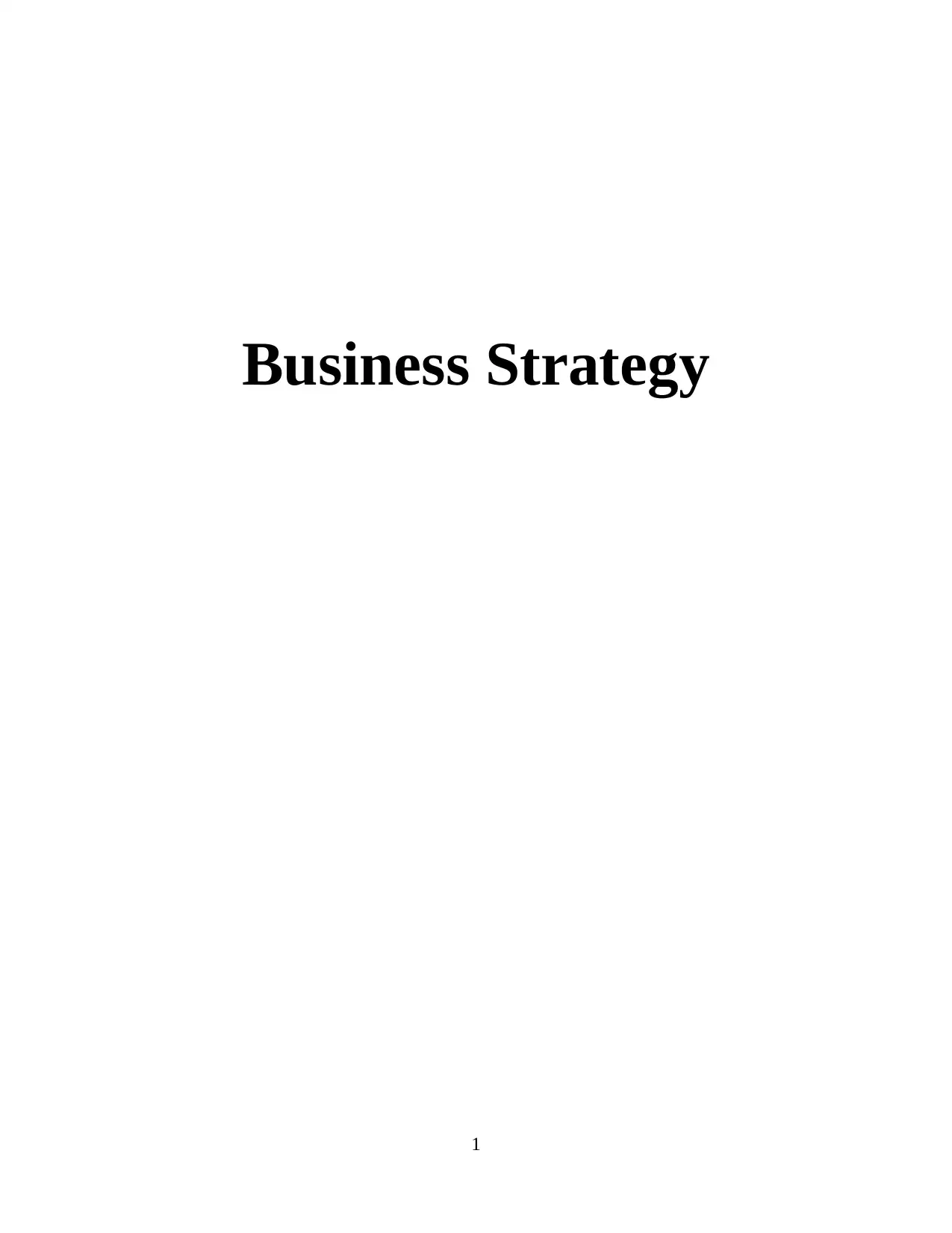
Business Strategy
1
1
Paraphrase This Document
Need a fresh take? Get an instant paraphrase of this document with our AI Paraphraser
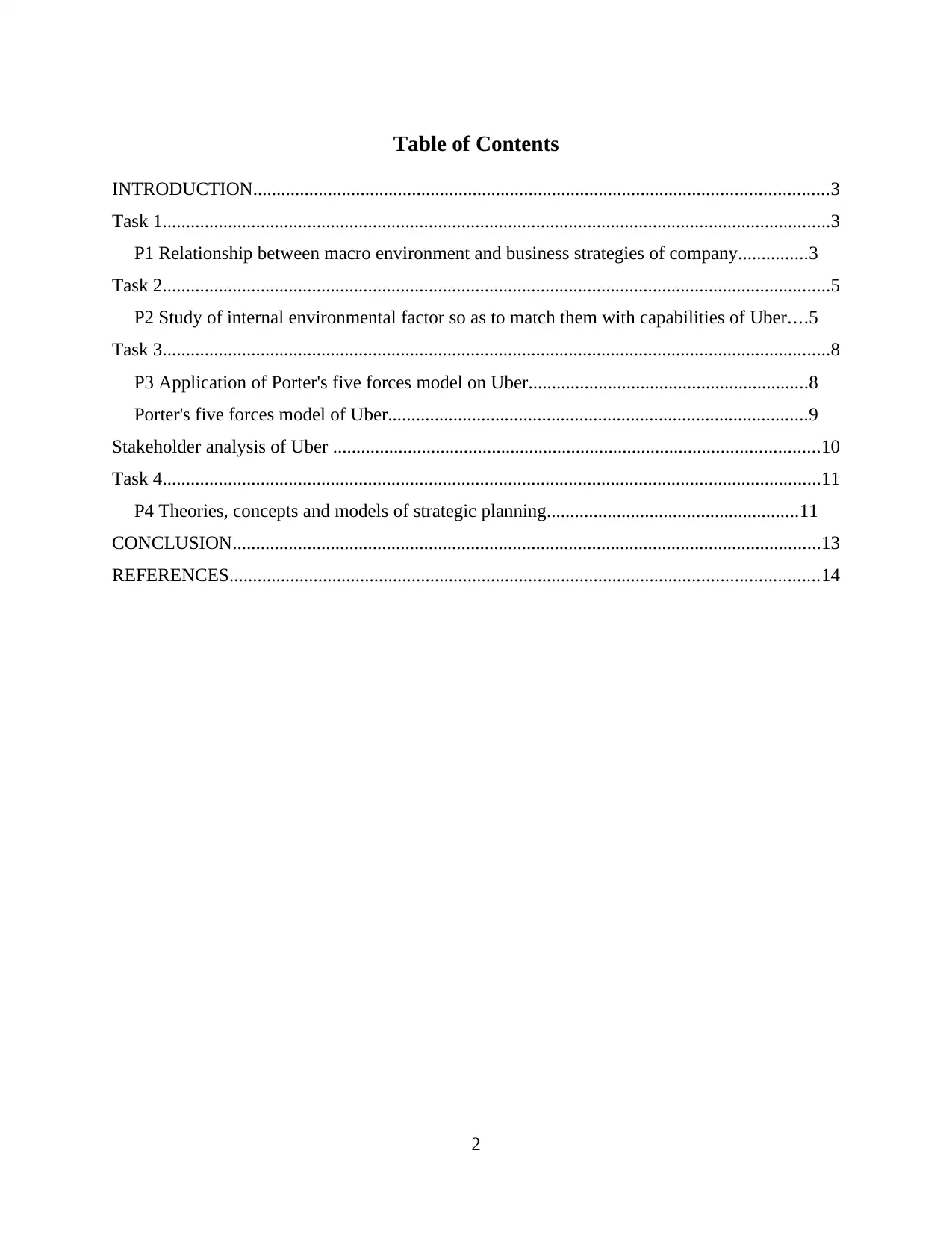
Table of Contents
INTRODUCTION...........................................................................................................................3
Task 1...............................................................................................................................................3
P1 Relationship between macro environment and business strategies of company...............3
Task 2...............................................................................................................................................5
P2 Study of internal environmental factor so as to match them with capabilities of Uber....5
Task 3...............................................................................................................................................8
P3 Application of Porter's five forces model on Uber............................................................8
Porter's five forces model of Uber..........................................................................................9
Stakeholder analysis of Uber ........................................................................................................10
Task 4.............................................................................................................................................11
P4 Theories, concepts and models of strategic planning......................................................11
CONCLUSION..............................................................................................................................13
REFERENCES..............................................................................................................................14
2
INTRODUCTION...........................................................................................................................3
Task 1...............................................................................................................................................3
P1 Relationship between macro environment and business strategies of company...............3
Task 2...............................................................................................................................................5
P2 Study of internal environmental factor so as to match them with capabilities of Uber....5
Task 3...............................................................................................................................................8
P3 Application of Porter's five forces model on Uber............................................................8
Porter's five forces model of Uber..........................................................................................9
Stakeholder analysis of Uber ........................................................................................................10
Task 4.............................................................................................................................................11
P4 Theories, concepts and models of strategic planning......................................................11
CONCLUSION..............................................................................................................................13
REFERENCES..............................................................................................................................14
2
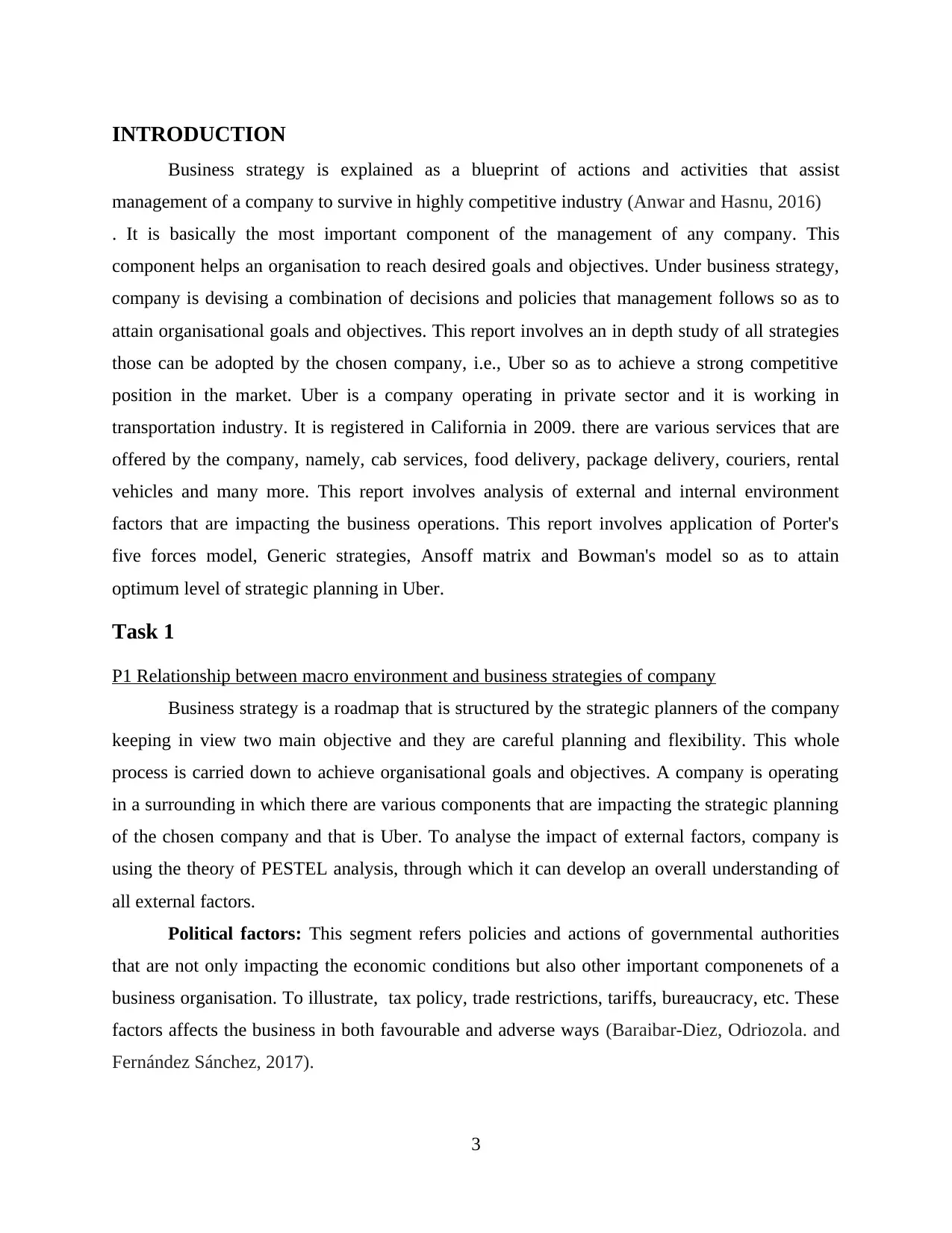
INTRODUCTION
Business strategy is explained as a blueprint of actions and activities that assist
management of a company to survive in highly competitive industry (Anwar and Hasnu, 2016)
. It is basically the most important component of the management of any company. This
component helps an organisation to reach desired goals and objectives. Under business strategy,
company is devising a combination of decisions and policies that management follows so as to
attain organisational goals and objectives. This report involves an in depth study of all strategies
those can be adopted by the chosen company, i.e., Uber so as to achieve a strong competitive
position in the market. Uber is a company operating in private sector and it is working in
transportation industry. It is registered in California in 2009. there are various services that are
offered by the company, namely, cab services, food delivery, package delivery, couriers, rental
vehicles and many more. This report involves analysis of external and internal environment
factors that are impacting the business operations. This report involves application of Porter's
five forces model, Generic strategies, Ansoff matrix and Bowman's model so as to attain
optimum level of strategic planning in Uber.
Task 1
P1 Relationship between macro environment and business strategies of company
Business strategy is a roadmap that is structured by the strategic planners of the company
keeping in view two main objective and they are careful planning and flexibility. This whole
process is carried down to achieve organisational goals and objectives. A company is operating
in a surrounding in which there are various components that are impacting the strategic planning
of the chosen company and that is Uber. To analyse the impact of external factors, company is
using the theory of PESTEL analysis, through which it can develop an overall understanding of
all external factors.
Political factors: This segment refers policies and actions of governmental authorities
that are not only impacting the economic conditions but also other important componenets of a
business organisation. To illustrate, tax policy, trade restrictions, tariffs, bureaucracy, etc. These
factors affects the business in both favourable and adverse ways (Baraibar‐Diez, Odriozola. and
Fernández Sánchez, 2017).
3
Business strategy is explained as a blueprint of actions and activities that assist
management of a company to survive in highly competitive industry (Anwar and Hasnu, 2016)
. It is basically the most important component of the management of any company. This
component helps an organisation to reach desired goals and objectives. Under business strategy,
company is devising a combination of decisions and policies that management follows so as to
attain organisational goals and objectives. This report involves an in depth study of all strategies
those can be adopted by the chosen company, i.e., Uber so as to achieve a strong competitive
position in the market. Uber is a company operating in private sector and it is working in
transportation industry. It is registered in California in 2009. there are various services that are
offered by the company, namely, cab services, food delivery, package delivery, couriers, rental
vehicles and many more. This report involves analysis of external and internal environment
factors that are impacting the business operations. This report involves application of Porter's
five forces model, Generic strategies, Ansoff matrix and Bowman's model so as to attain
optimum level of strategic planning in Uber.
Task 1
P1 Relationship between macro environment and business strategies of company
Business strategy is a roadmap that is structured by the strategic planners of the company
keeping in view two main objective and they are careful planning and flexibility. This whole
process is carried down to achieve organisational goals and objectives. A company is operating
in a surrounding in which there are various components that are impacting the strategic planning
of the chosen company and that is Uber. To analyse the impact of external factors, company is
using the theory of PESTEL analysis, through which it can develop an overall understanding of
all external factors.
Political factors: This segment refers policies and actions of governmental authorities
that are not only impacting the economic conditions but also other important componenets of a
business organisation. To illustrate, tax policy, trade restrictions, tariffs, bureaucracy, etc. These
factors affects the business in both favourable and adverse ways (Baraibar‐Diez, Odriozola. and
Fernández Sánchez, 2017).
3
⊘ This is a preview!⊘
Do you want full access?
Subscribe today to unlock all pages.

Trusted by 1+ million students worldwide
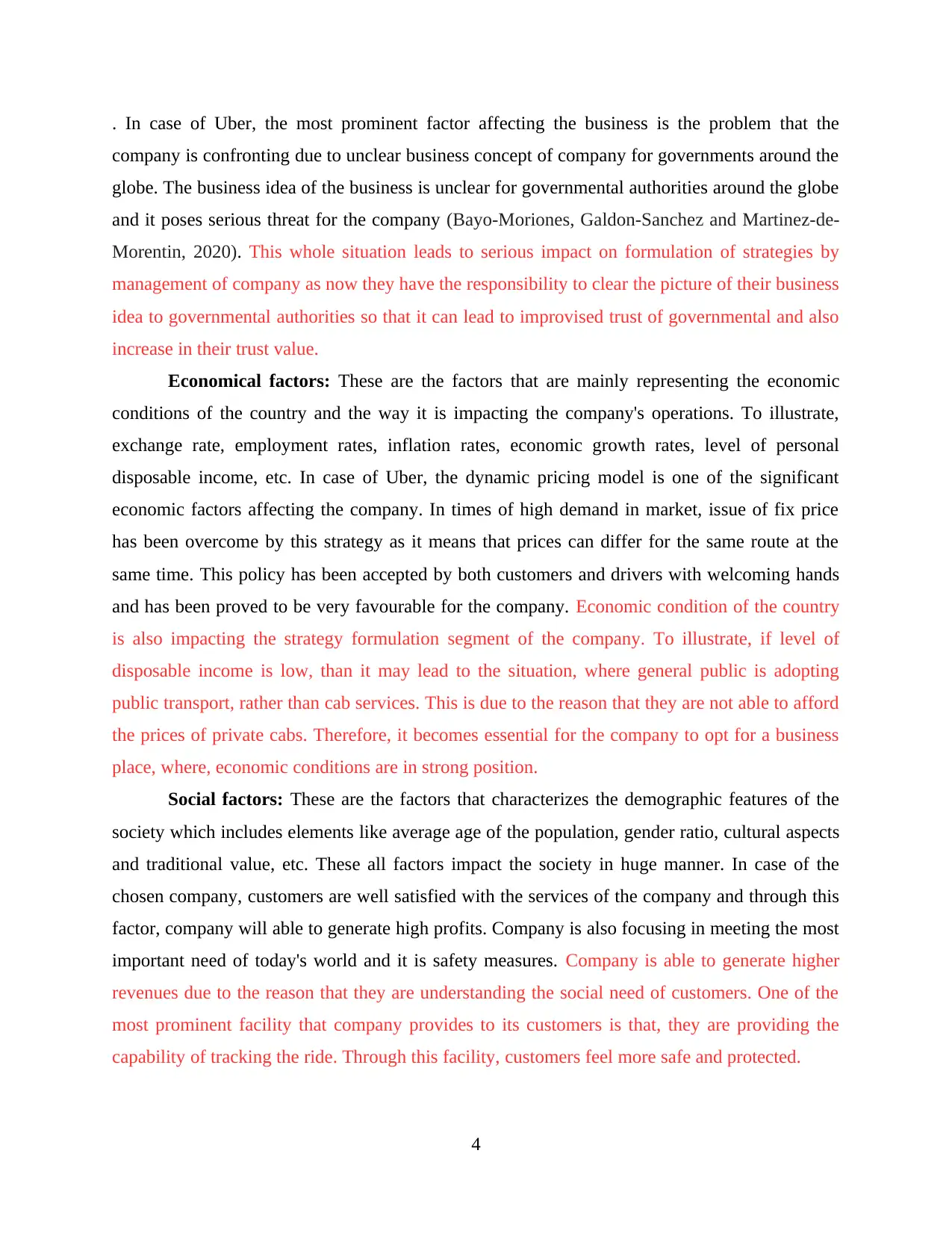
. In case of Uber, the most prominent factor affecting the business is the problem that the
company is confronting due to unclear business concept of company for governments around the
globe. The business idea of the business is unclear for governmental authorities around the globe
and it poses serious threat for the company (Bayo-Moriones, Galdon-Sanchez and Martinez-de-
Morentin, 2020). This whole situation leads to serious impact on formulation of strategies by
management of company as now they have the responsibility to clear the picture of their business
idea to governmental authorities so that it can lead to improvised trust of governmental and also
increase in their trust value.
Economical factors: These are the factors that are mainly representing the economic
conditions of the country and the way it is impacting the company's operations. To illustrate,
exchange rate, employment rates, inflation rates, economic growth rates, level of personal
disposable income, etc. In case of Uber, the dynamic pricing model is one of the significant
economic factors affecting the company. In times of high demand in market, issue of fix price
has been overcome by this strategy as it means that prices can differ for the same route at the
same time. This policy has been accepted by both customers and drivers with welcoming hands
and has been proved to be very favourable for the company. Economic condition of the country
is also impacting the strategy formulation segment of the company. To illustrate, if level of
disposable income is low, than it may lead to the situation, where general public is adopting
public transport, rather than cab services. This is due to the reason that they are not able to afford
the prices of private cabs. Therefore, it becomes essential for the company to opt for a business
place, where, economic conditions are in strong position.
Social factors: These are the factors that characterizes the demographic features of the
society which includes elements like average age of the population, gender ratio, cultural aspects
and traditional value, etc. These all factors impact the society in huge manner. In case of the
chosen company, customers are well satisfied with the services of the company and through this
factor, company will able to generate high profits. Company is also focusing in meeting the most
important need of today's world and it is safety measures. Company is able to generate higher
revenues due to the reason that they are understanding the social need of customers. One of the
most prominent facility that company provides to its customers is that, they are providing the
capability of tracking the ride. Through this facility, customers feel more safe and protected.
4
company is confronting due to unclear business concept of company for governments around the
globe. The business idea of the business is unclear for governmental authorities around the globe
and it poses serious threat for the company (Bayo-Moriones, Galdon-Sanchez and Martinez-de-
Morentin, 2020). This whole situation leads to serious impact on formulation of strategies by
management of company as now they have the responsibility to clear the picture of their business
idea to governmental authorities so that it can lead to improvised trust of governmental and also
increase in their trust value.
Economical factors: These are the factors that are mainly representing the economic
conditions of the country and the way it is impacting the company's operations. To illustrate,
exchange rate, employment rates, inflation rates, economic growth rates, level of personal
disposable income, etc. In case of Uber, the dynamic pricing model is one of the significant
economic factors affecting the company. In times of high demand in market, issue of fix price
has been overcome by this strategy as it means that prices can differ for the same route at the
same time. This policy has been accepted by both customers and drivers with welcoming hands
and has been proved to be very favourable for the company. Economic condition of the country
is also impacting the strategy formulation segment of the company. To illustrate, if level of
disposable income is low, than it may lead to the situation, where general public is adopting
public transport, rather than cab services. This is due to the reason that they are not able to afford
the prices of private cabs. Therefore, it becomes essential for the company to opt for a business
place, where, economic conditions are in strong position.
Social factors: These are the factors that characterizes the demographic features of the
society which includes elements like average age of the population, gender ratio, cultural aspects
and traditional value, etc. These all factors impact the society in huge manner. In case of the
chosen company, customers are well satisfied with the services of the company and through this
factor, company will able to generate high profits. Company is also focusing in meeting the most
important need of today's world and it is safety measures. Company is able to generate higher
revenues due to the reason that they are understanding the social need of customers. One of the
most prominent facility that company provides to its customers is that, they are providing the
capability of tracking the ride. Through this facility, customers feel more safe and protected.
4
Paraphrase This Document
Need a fresh take? Get an instant paraphrase of this document with our AI Paraphraser
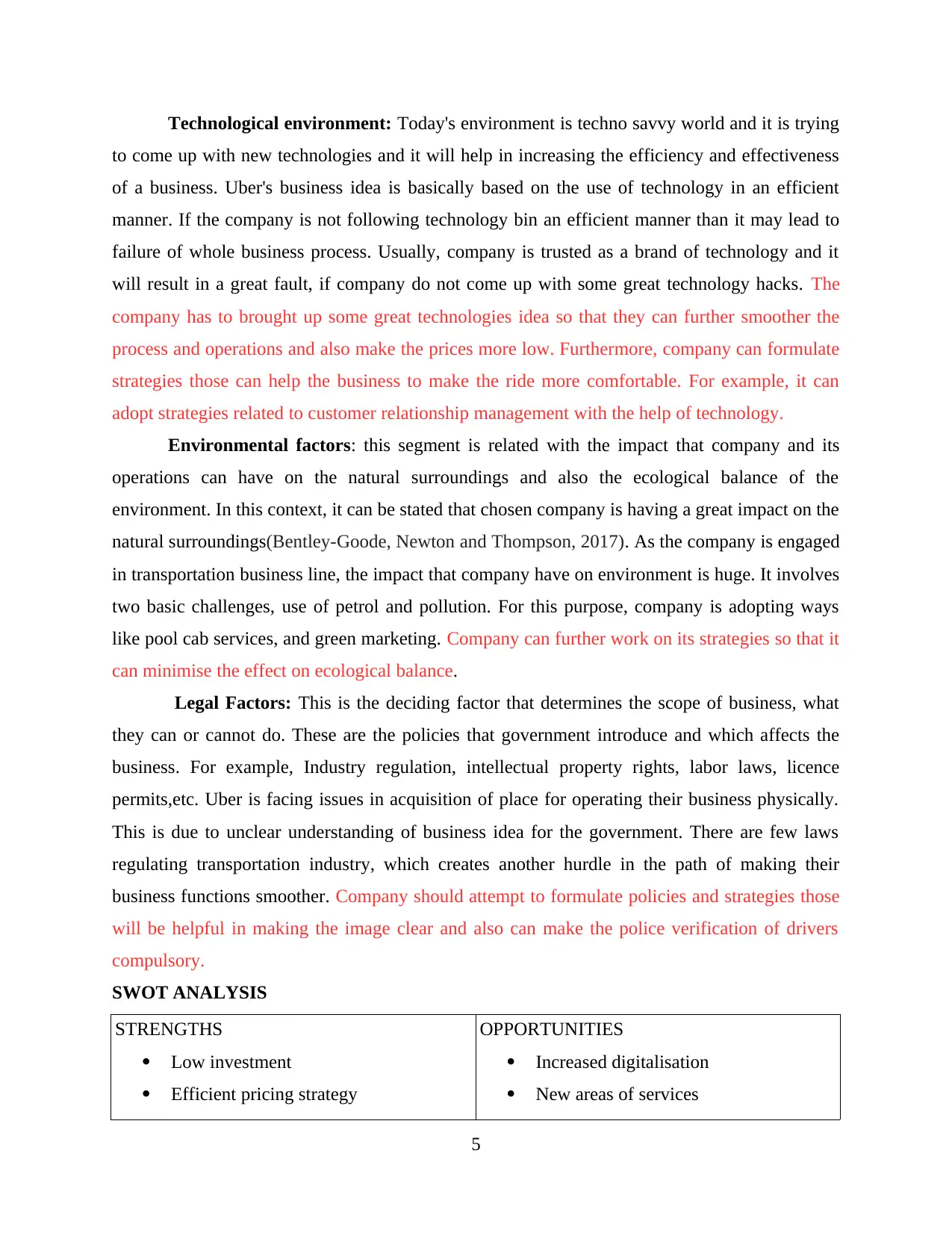
Technological environment: Today's environment is techno savvy world and it is trying
to come up with new technologies and it will help in increasing the efficiency and effectiveness
of a business. Uber's business idea is basically based on the use of technology in an efficient
manner. If the company is not following technology bin an efficient manner than it may lead to
failure of whole business process. Usually, company is trusted as a brand of technology and it
will result in a great fault, if company do not come up with some great technology hacks. The
company has to brought up some great technologies idea so that they can further smoother the
process and operations and also make the prices more low. Furthermore, company can formulate
strategies those can help the business to make the ride more comfortable. For example, it can
adopt strategies related to customer relationship management with the help of technology.
Environmental factors: this segment is related with the impact that company and its
operations can have on the natural surroundings and also the ecological balance of the
environment. In this context, it can be stated that chosen company is having a great impact on the
natural surroundings(Bentley-Goode, Newton and Thompson, 2017). As the company is engaged
in transportation business line, the impact that company have on environment is huge. It involves
two basic challenges, use of petrol and pollution. For this purpose, company is adopting ways
like pool cab services, and green marketing. Company can further work on its strategies so that it
can minimise the effect on ecological balance.
Legal Factors: This is the deciding factor that determines the scope of business, what
they can or cannot do. These are the policies that government introduce and which affects the
business. For example, Industry regulation, intellectual property rights, labor laws, licence
permits,etc. Uber is facing issues in acquisition of place for operating their business physically.
This is due to unclear understanding of business idea for the government. There are few laws
regulating transportation industry, which creates another hurdle in the path of making their
business functions smoother. Company should attempt to formulate policies and strategies those
will be helpful in making the image clear and also can make the police verification of drivers
compulsory.
SWOT ANALYSIS
STRENGTHS
Low investment
Efficient pricing strategy
OPPORTUNITIES
Increased digitalisation
New areas of services
5
to come up with new technologies and it will help in increasing the efficiency and effectiveness
of a business. Uber's business idea is basically based on the use of technology in an efficient
manner. If the company is not following technology bin an efficient manner than it may lead to
failure of whole business process. Usually, company is trusted as a brand of technology and it
will result in a great fault, if company do not come up with some great technology hacks. The
company has to brought up some great technologies idea so that they can further smoother the
process and operations and also make the prices more low. Furthermore, company can formulate
strategies those can help the business to make the ride more comfortable. For example, it can
adopt strategies related to customer relationship management with the help of technology.
Environmental factors: this segment is related with the impact that company and its
operations can have on the natural surroundings and also the ecological balance of the
environment. In this context, it can be stated that chosen company is having a great impact on the
natural surroundings(Bentley-Goode, Newton and Thompson, 2017). As the company is engaged
in transportation business line, the impact that company have on environment is huge. It involves
two basic challenges, use of petrol and pollution. For this purpose, company is adopting ways
like pool cab services, and green marketing. Company can further work on its strategies so that it
can minimise the effect on ecological balance.
Legal Factors: This is the deciding factor that determines the scope of business, what
they can or cannot do. These are the policies that government introduce and which affects the
business. For example, Industry regulation, intellectual property rights, labor laws, licence
permits,etc. Uber is facing issues in acquisition of place for operating their business physically.
This is due to unclear understanding of business idea for the government. There are few laws
regulating transportation industry, which creates another hurdle in the path of making their
business functions smoother. Company should attempt to formulate policies and strategies those
will be helpful in making the image clear and also can make the police verification of drivers
compulsory.
SWOT ANALYSIS
STRENGTHS
Low investment
Efficient pricing strategy
OPPORTUNITIES
Increased digitalisation
New areas of services
5
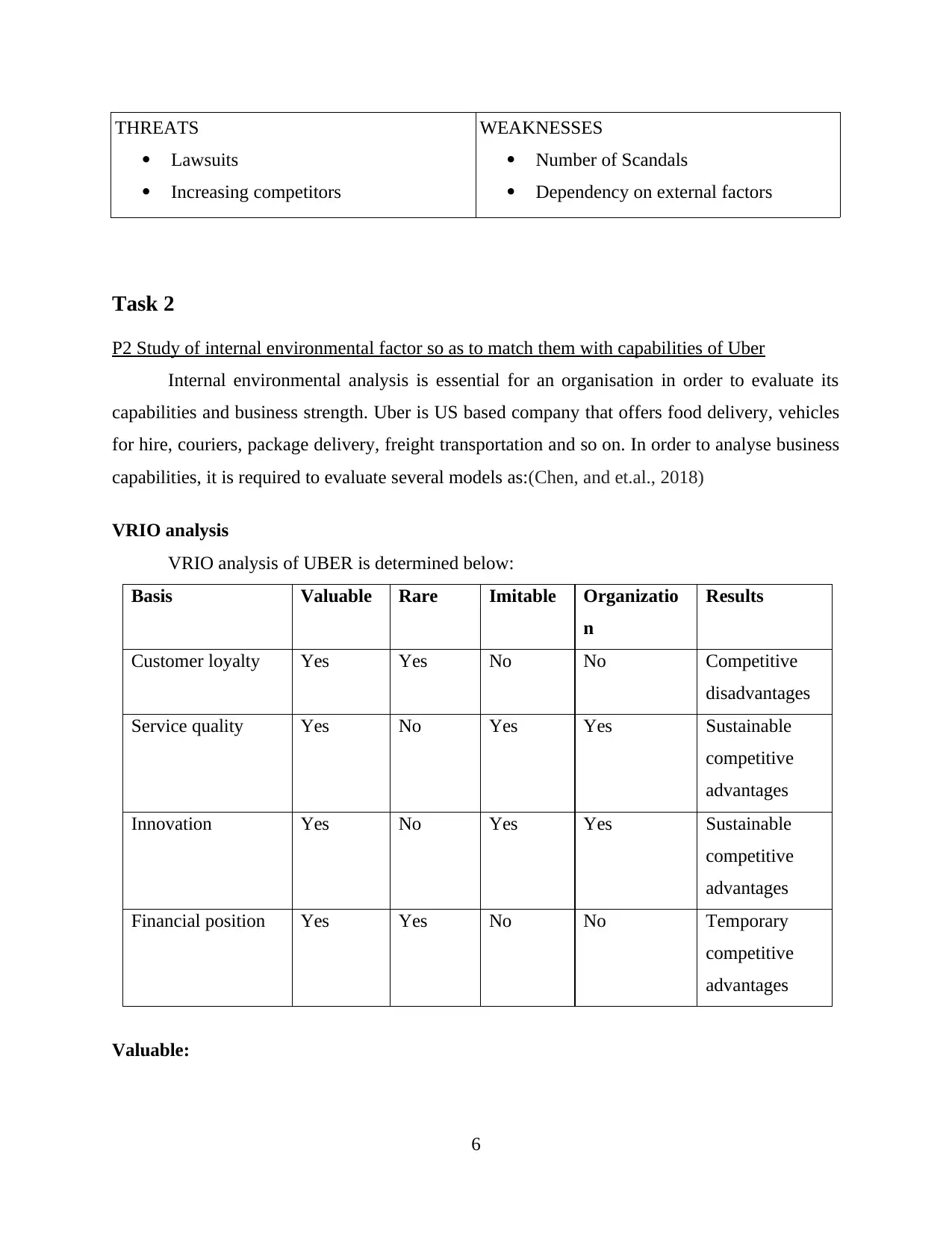
THREATS
Lawsuits
Increasing competitors
WEAKNESSES
Number of Scandals
Dependency on external factors
Task 2
P2 Study of internal environmental factor so as to match them with capabilities of Uber
Internal environmental analysis is essential for an organisation in order to evaluate its
capabilities and business strength. Uber is US based company that offers food delivery, vehicles
for hire, couriers, package delivery, freight transportation and so on. In order to analyse business
capabilities, it is required to evaluate several models as:(Chen, and et.al., 2018)
VRIO analysis
VRIO analysis of UBER is determined below:
Basis Valuable Rare Imitable Organizatio
n
Results
Customer loyalty Yes Yes No No Competitive
disadvantages
Service quality Yes No Yes Yes Sustainable
competitive
advantages
Innovation Yes No Yes Yes Sustainable
competitive
advantages
Financial position Yes Yes No No Temporary
competitive
advantages
Valuable:
6
Lawsuits
Increasing competitors
WEAKNESSES
Number of Scandals
Dependency on external factors
Task 2
P2 Study of internal environmental factor so as to match them with capabilities of Uber
Internal environmental analysis is essential for an organisation in order to evaluate its
capabilities and business strength. Uber is US based company that offers food delivery, vehicles
for hire, couriers, package delivery, freight transportation and so on. In order to analyse business
capabilities, it is required to evaluate several models as:(Chen, and et.al., 2018)
VRIO analysis
VRIO analysis of UBER is determined below:
Basis Valuable Rare Imitable Organizatio
n
Results
Customer loyalty Yes Yes No No Competitive
disadvantages
Service quality Yes No Yes Yes Sustainable
competitive
advantages
Innovation Yes No Yes Yes Sustainable
competitive
advantages
Financial position Yes Yes No No Temporary
competitive
advantages
Valuable:
6
⊘ This is a preview!⊘
Do you want full access?
Subscribe today to unlock all pages.

Trusted by 1+ million students worldwide
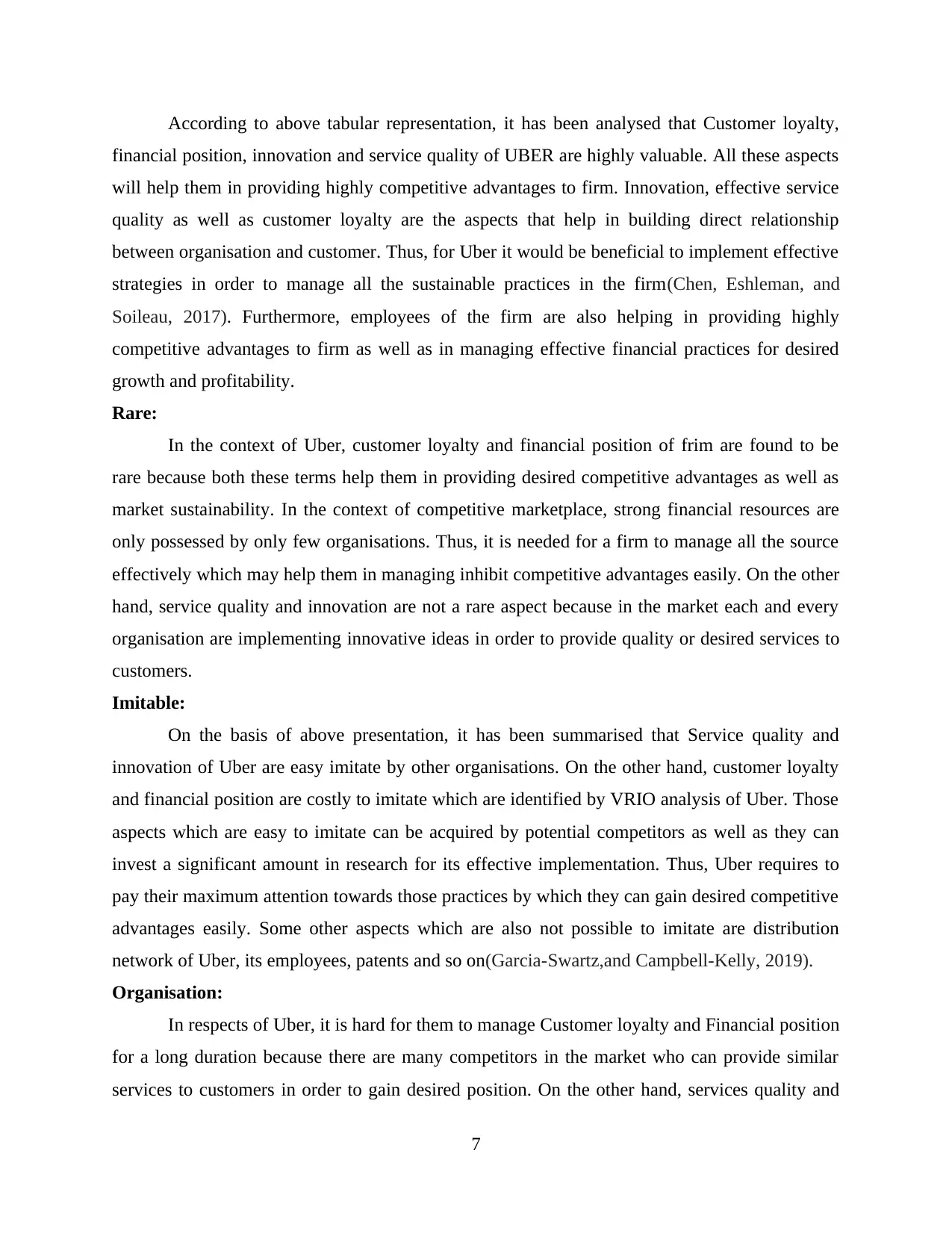
According to above tabular representation, it has been analysed that Customer loyalty,
financial position, innovation and service quality of UBER are highly valuable. All these aspects
will help them in providing highly competitive advantages to firm. Innovation, effective service
quality as well as customer loyalty are the aspects that help in building direct relationship
between organisation and customer. Thus, for Uber it would be beneficial to implement effective
strategies in order to manage all the sustainable practices in the firm(Chen, Eshleman, and
Soileau, 2017). Furthermore, employees of the firm are also helping in providing highly
competitive advantages to firm as well as in managing effective financial practices for desired
growth and profitability.
Rare:
In the context of Uber, customer loyalty and financial position of frim are found to be
rare because both these terms help them in providing desired competitive advantages as well as
market sustainability. In the context of competitive marketplace, strong financial resources are
only possessed by only few organisations. Thus, it is needed for a firm to manage all the source
effectively which may help them in managing inhibit competitive advantages easily. On the other
hand, service quality and innovation are not a rare aspect because in the market each and every
organisation are implementing innovative ideas in order to provide quality or desired services to
customers.
Imitable:
On the basis of above presentation, it has been summarised that Service quality and
innovation of Uber are easy imitate by other organisations. On the other hand, customer loyalty
and financial position are costly to imitate which are identified by VRIO analysis of Uber. Those
aspects which are easy to imitate can be acquired by potential competitors as well as they can
invest a significant amount in research for its effective implementation. Thus, Uber requires to
pay their maximum attention towards those practices by which they can gain desired competitive
advantages easily. Some other aspects which are also not possible to imitate are distribution
network of Uber, its employees, patents and so on(Garcia-Swartz,and Campbell-Kelly, 2019).
Organisation:
In respects of Uber, it is hard for them to manage Customer loyalty and Financial position
for a long duration because there are many competitors in the market who can provide similar
services to customers in order to gain desired position. On the other hand, services quality and
7
financial position, innovation and service quality of UBER are highly valuable. All these aspects
will help them in providing highly competitive advantages to firm. Innovation, effective service
quality as well as customer loyalty are the aspects that help in building direct relationship
between organisation and customer. Thus, for Uber it would be beneficial to implement effective
strategies in order to manage all the sustainable practices in the firm(Chen, Eshleman, and
Soileau, 2017). Furthermore, employees of the firm are also helping in providing highly
competitive advantages to firm as well as in managing effective financial practices for desired
growth and profitability.
Rare:
In the context of Uber, customer loyalty and financial position of frim are found to be
rare because both these terms help them in providing desired competitive advantages as well as
market sustainability. In the context of competitive marketplace, strong financial resources are
only possessed by only few organisations. Thus, it is needed for a firm to manage all the source
effectively which may help them in managing inhibit competitive advantages easily. On the other
hand, service quality and innovation are not a rare aspect because in the market each and every
organisation are implementing innovative ideas in order to provide quality or desired services to
customers.
Imitable:
On the basis of above presentation, it has been summarised that Service quality and
innovation of Uber are easy imitate by other organisations. On the other hand, customer loyalty
and financial position are costly to imitate which are identified by VRIO analysis of Uber. Those
aspects which are easy to imitate can be acquired by potential competitors as well as they can
invest a significant amount in research for its effective implementation. Thus, Uber requires to
pay their maximum attention towards those practices by which they can gain desired competitive
advantages easily. Some other aspects which are also not possible to imitate are distribution
network of Uber, its employees, patents and so on(Garcia-Swartz,and Campbell-Kelly, 2019).
Organisation:
In respects of Uber, it is hard for them to manage Customer loyalty and Financial position
for a long duration because there are many competitors in the market who can provide similar
services to customers in order to gain desired position. On the other hand, services quality and
7
Paraphrase This Document
Need a fresh take? Get an instant paraphrase of this document with our AI Paraphraser
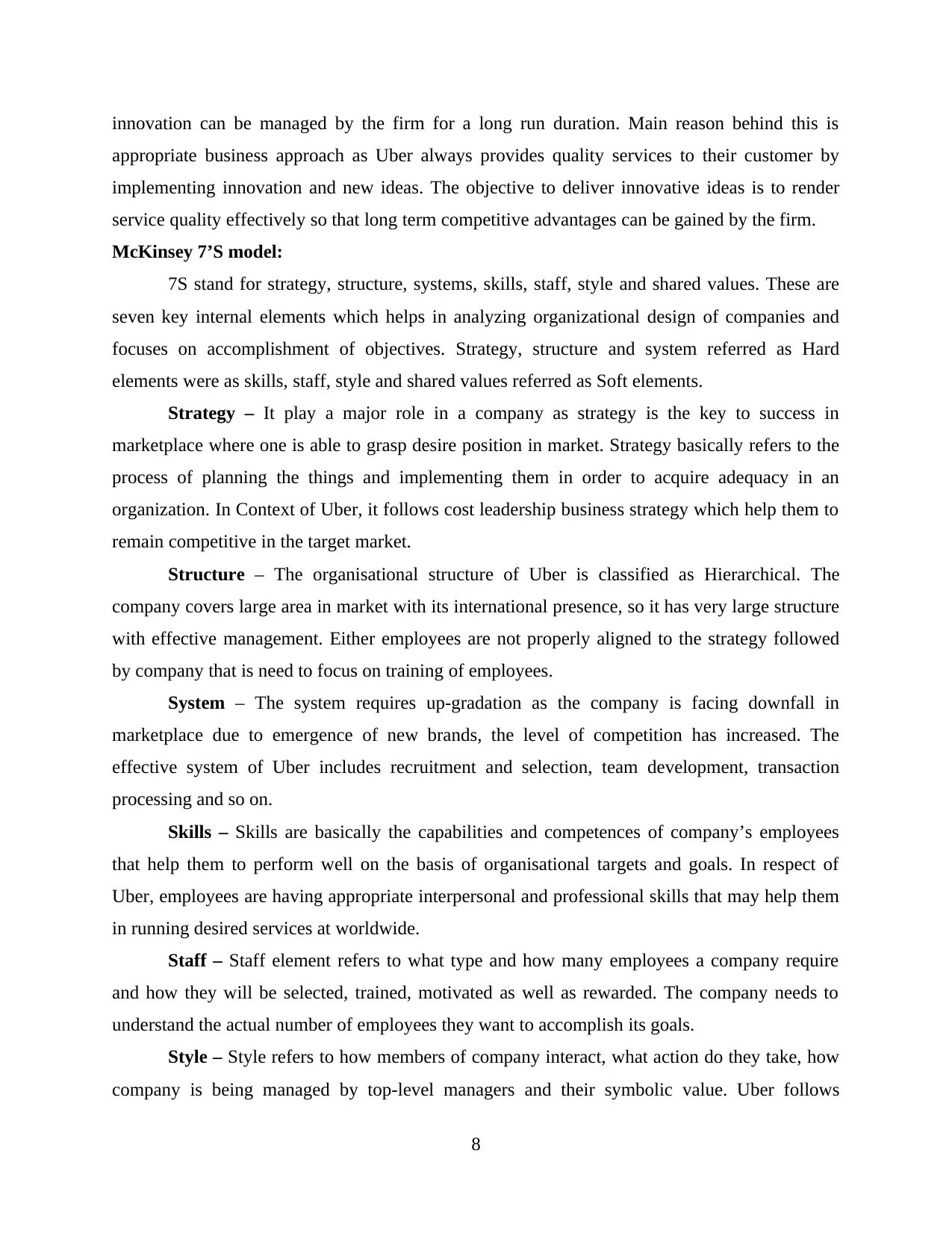
innovation can be managed by the firm for a long run duration. Main reason behind this is
appropriate business approach as Uber always provides quality services to their customer by
implementing innovation and new ideas. The objective to deliver innovative ideas is to render
service quality effectively so that long term competitive advantages can be gained by the firm.
McKinsey 7’S model:
7S stand for strategy, structure, systems, skills, staff, style and shared values. These are
seven key internal elements which helps in analyzing organizational design of companies and
focuses on accomplishment of objectives. Strategy, structure and system referred as Hard
elements were as skills, staff, style and shared values referred as Soft elements.
Strategy – It play a major role in a company as strategy is the key to success in
marketplace where one is able to grasp desire position in market. Strategy basically refers to the
process of planning the things and implementing them in order to acquire adequacy in an
organization. In Context of Uber, it follows cost leadership business strategy which help them to
remain competitive in the target market.
Structure – The organisational structure of Uber is classified as Hierarchical. The
company covers large area in market with its international presence, so it has very large structure
with effective management. Either employees are not properly aligned to the strategy followed
by company that is need to focus on training of employees.
System – The system requires up-gradation as the company is facing downfall in
marketplace due to emergence of new brands, the level of competition has increased. The
effective system of Uber includes recruitment and selection, team development, transaction
processing and so on.
Skills – Skills are basically the capabilities and competences of company’s employees
that help them to perform well on the basis of organisational targets and goals. In respect of
Uber, employees are having appropriate interpersonal and professional skills that may help them
in running desired services at worldwide.
Staff – Staff element refers to what type and how many employees a company require
and how they will be selected, trained, motivated as well as rewarded. The company needs to
understand the actual number of employees they want to accomplish its goals.
Style – Style refers to how members of company interact, what action do they take, how
company is being managed by top-level managers and their symbolic value. Uber follows
8
appropriate business approach as Uber always provides quality services to their customer by
implementing innovation and new ideas. The objective to deliver innovative ideas is to render
service quality effectively so that long term competitive advantages can be gained by the firm.
McKinsey 7’S model:
7S stand for strategy, structure, systems, skills, staff, style and shared values. These are
seven key internal elements which helps in analyzing organizational design of companies and
focuses on accomplishment of objectives. Strategy, structure and system referred as Hard
elements were as skills, staff, style and shared values referred as Soft elements.
Strategy – It play a major role in a company as strategy is the key to success in
marketplace where one is able to grasp desire position in market. Strategy basically refers to the
process of planning the things and implementing them in order to acquire adequacy in an
organization. In Context of Uber, it follows cost leadership business strategy which help them to
remain competitive in the target market.
Structure – The organisational structure of Uber is classified as Hierarchical. The
company covers large area in market with its international presence, so it has very large structure
with effective management. Either employees are not properly aligned to the strategy followed
by company that is need to focus on training of employees.
System – The system requires up-gradation as the company is facing downfall in
marketplace due to emergence of new brands, the level of competition has increased. The
effective system of Uber includes recruitment and selection, team development, transaction
processing and so on.
Skills – Skills are basically the capabilities and competences of company’s employees
that help them to perform well on the basis of organisational targets and goals. In respect of
Uber, employees are having appropriate interpersonal and professional skills that may help them
in running desired services at worldwide.
Staff – Staff element refers to what type and how many employees a company require
and how they will be selected, trained, motivated as well as rewarded. The company needs to
understand the actual number of employees they want to accomplish its goals.
Style – Style refers to how members of company interact, what action do they take, how
company is being managed by top-level managers and their symbolic value. Uber follows
8
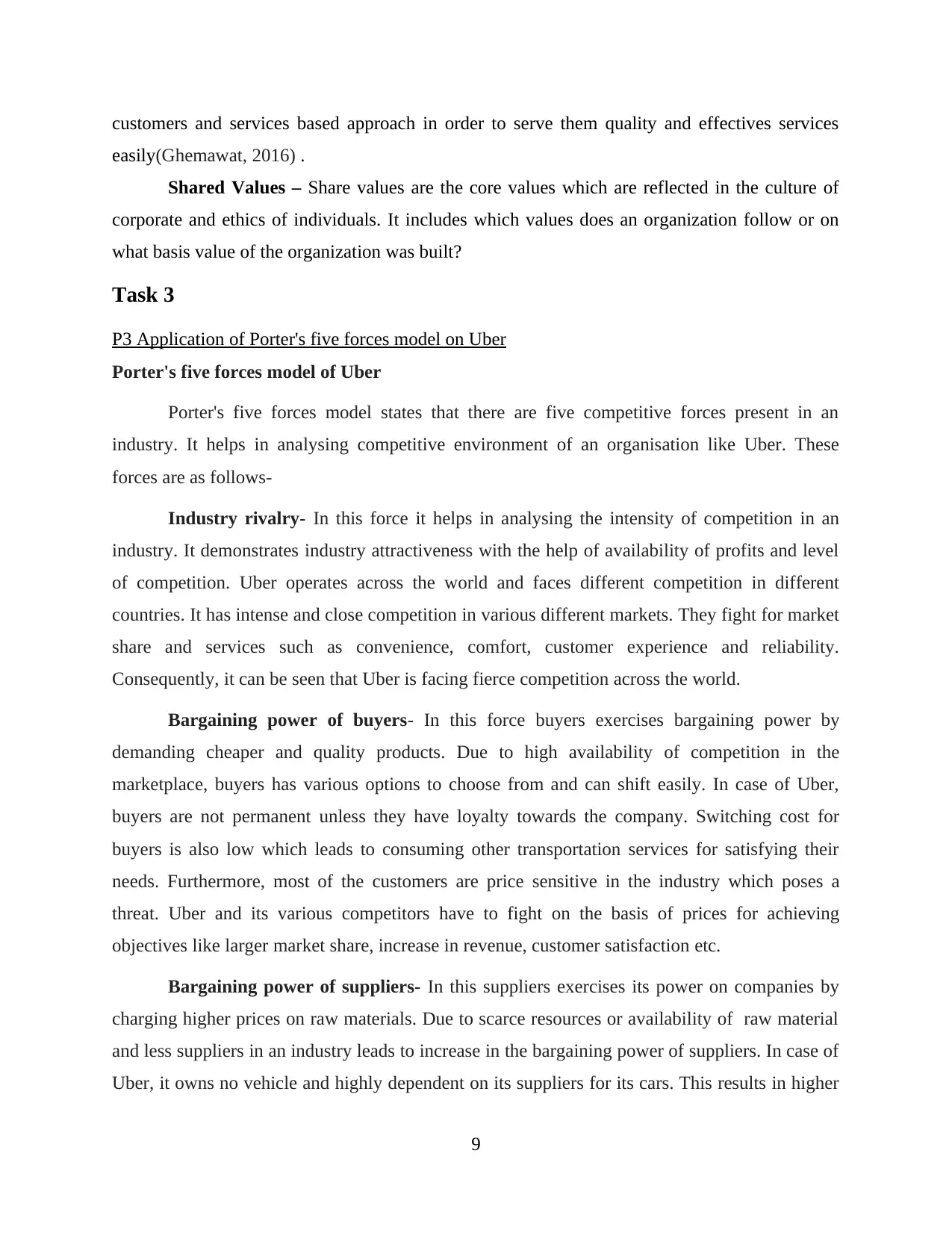
customers and services based approach in order to serve them quality and effectives services
easily(Ghemawat, 2016) .
Shared Values – Share values are the core values which are reflected in the culture of
corporate and ethics of individuals. It includes which values does an organization follow or on
what basis value of the organization was built?
Task 3
P3 Application of Porter's five forces model on Uber
Porter's five forces model of Uber
Porter's five forces model states that there are five competitive forces present in an
industry. It helps in analysing competitive environment of an organisation like Uber. These
forces are as follows-
Industry rivalry- In this force it helps in analysing the intensity of competition in an
industry. It demonstrates industry attractiveness with the help of availability of profits and level
of competition. Uber operates across the world and faces different competition in different
countries. It has intense and close competition in various different markets. They fight for market
share and services such as convenience, comfort, customer experience and reliability.
Consequently, it can be seen that Uber is facing fierce competition across the world.
Bargaining power of buyers- In this force buyers exercises bargaining power by
demanding cheaper and quality products. Due to high availability of competition in the
marketplace, buyers has various options to choose from and can shift easily. In case of Uber,
buyers are not permanent unless they have loyalty towards the company. Switching cost for
buyers is also low which leads to consuming other transportation services for satisfying their
needs. Furthermore, most of the customers are price sensitive in the industry which poses a
threat. Uber and its various competitors have to fight on the basis of prices for achieving
objectives like larger market share, increase in revenue, customer satisfaction etc.
Bargaining power of suppliers- In this suppliers exercises its power on companies by
charging higher prices on raw materials. Due to scarce resources or availability of raw material
and less suppliers in an industry leads to increase in the bargaining power of suppliers. In case of
Uber, it owns no vehicle and highly dependent on its suppliers for its cars. This results in higher
9
easily(Ghemawat, 2016) .
Shared Values – Share values are the core values which are reflected in the culture of
corporate and ethics of individuals. It includes which values does an organization follow or on
what basis value of the organization was built?
Task 3
P3 Application of Porter's five forces model on Uber
Porter's five forces model of Uber
Porter's five forces model states that there are five competitive forces present in an
industry. It helps in analysing competitive environment of an organisation like Uber. These
forces are as follows-
Industry rivalry- In this force it helps in analysing the intensity of competition in an
industry. It demonstrates industry attractiveness with the help of availability of profits and level
of competition. Uber operates across the world and faces different competition in different
countries. It has intense and close competition in various different markets. They fight for market
share and services such as convenience, comfort, customer experience and reliability.
Consequently, it can be seen that Uber is facing fierce competition across the world.
Bargaining power of buyers- In this force buyers exercises bargaining power by
demanding cheaper and quality products. Due to high availability of competition in the
marketplace, buyers has various options to choose from and can shift easily. In case of Uber,
buyers are not permanent unless they have loyalty towards the company. Switching cost for
buyers is also low which leads to consuming other transportation services for satisfying their
needs. Furthermore, most of the customers are price sensitive in the industry which poses a
threat. Uber and its various competitors have to fight on the basis of prices for achieving
objectives like larger market share, increase in revenue, customer satisfaction etc.
Bargaining power of suppliers- In this suppliers exercises its power on companies by
charging higher prices on raw materials. Due to scarce resources or availability of raw material
and less suppliers in an industry leads to increase in the bargaining power of suppliers. In case of
Uber, it owns no vehicle and highly dependent on its suppliers for its cars. This results in higher
9
⊘ This is a preview!⊘
Do you want full access?
Subscribe today to unlock all pages.

Trusted by 1+ million students worldwide
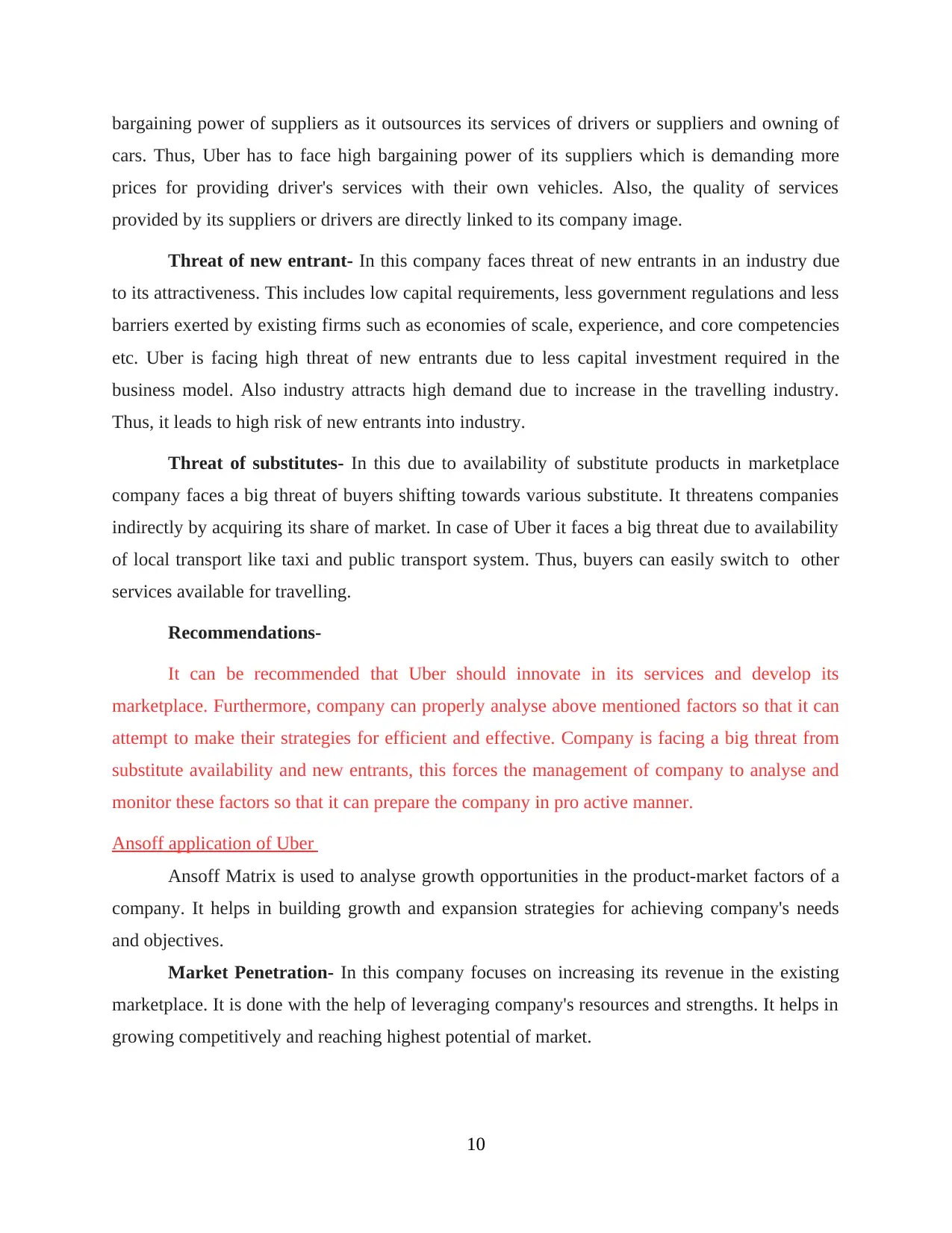
bargaining power of suppliers as it outsources its services of drivers or suppliers and owning of
cars. Thus, Uber has to face high bargaining power of its suppliers which is demanding more
prices for providing driver's services with their own vehicles. Also, the quality of services
provided by its suppliers or drivers are directly linked to its company image.
Threat of new entrant- In this company faces threat of new entrants in an industry due
to its attractiveness. This includes low capital requirements, less government regulations and less
barriers exerted by existing firms such as economies of scale, experience, and core competencies
etc. Uber is facing high threat of new entrants due to less capital investment required in the
business model. Also industry attracts high demand due to increase in the travelling industry.
Thus, it leads to high risk of new entrants into industry.
Threat of substitutes- In this due to availability of substitute products in marketplace
company faces a big threat of buyers shifting towards various substitute. It threatens companies
indirectly by acquiring its share of market. In case of Uber it faces a big threat due to availability
of local transport like taxi and public transport system. Thus, buyers can easily switch to other
services available for travelling.
Recommendations-
It can be recommended that Uber should innovate in its services and develop its
marketplace. Furthermore, company can properly analyse above mentioned factors so that it can
attempt to make their strategies for efficient and effective. Company is facing a big threat from
substitute availability and new entrants, this forces the management of company to analyse and
monitor these factors so that it can prepare the company in pro active manner.
Ansoff application of Uber
Ansoff Matrix is used to analyse growth opportunities in the product-market factors of a
company. It helps in building growth and expansion strategies for achieving company's needs
and objectives.
Market Penetration- In this company focuses on increasing its revenue in the existing
marketplace. It is done with the help of leveraging company's resources and strengths. It helps in
growing competitively and reaching highest potential of market.
10
cars. Thus, Uber has to face high bargaining power of its suppliers which is demanding more
prices for providing driver's services with their own vehicles. Also, the quality of services
provided by its suppliers or drivers are directly linked to its company image.
Threat of new entrant- In this company faces threat of new entrants in an industry due
to its attractiveness. This includes low capital requirements, less government regulations and less
barriers exerted by existing firms such as economies of scale, experience, and core competencies
etc. Uber is facing high threat of new entrants due to less capital investment required in the
business model. Also industry attracts high demand due to increase in the travelling industry.
Thus, it leads to high risk of new entrants into industry.
Threat of substitutes- In this due to availability of substitute products in marketplace
company faces a big threat of buyers shifting towards various substitute. It threatens companies
indirectly by acquiring its share of market. In case of Uber it faces a big threat due to availability
of local transport like taxi and public transport system. Thus, buyers can easily switch to other
services available for travelling.
Recommendations-
It can be recommended that Uber should innovate in its services and develop its
marketplace. Furthermore, company can properly analyse above mentioned factors so that it can
attempt to make their strategies for efficient and effective. Company is facing a big threat from
substitute availability and new entrants, this forces the management of company to analyse and
monitor these factors so that it can prepare the company in pro active manner.
Ansoff application of Uber
Ansoff Matrix is used to analyse growth opportunities in the product-market factors of a
company. It helps in building growth and expansion strategies for achieving company's needs
and objectives.
Market Penetration- In this company focuses on increasing its revenue in the existing
marketplace. It is done with the help of leveraging company's resources and strengths. It helps in
growing competitively and reaching highest potential of market.
10
Paraphrase This Document
Need a fresh take? Get an instant paraphrase of this document with our AI Paraphraser
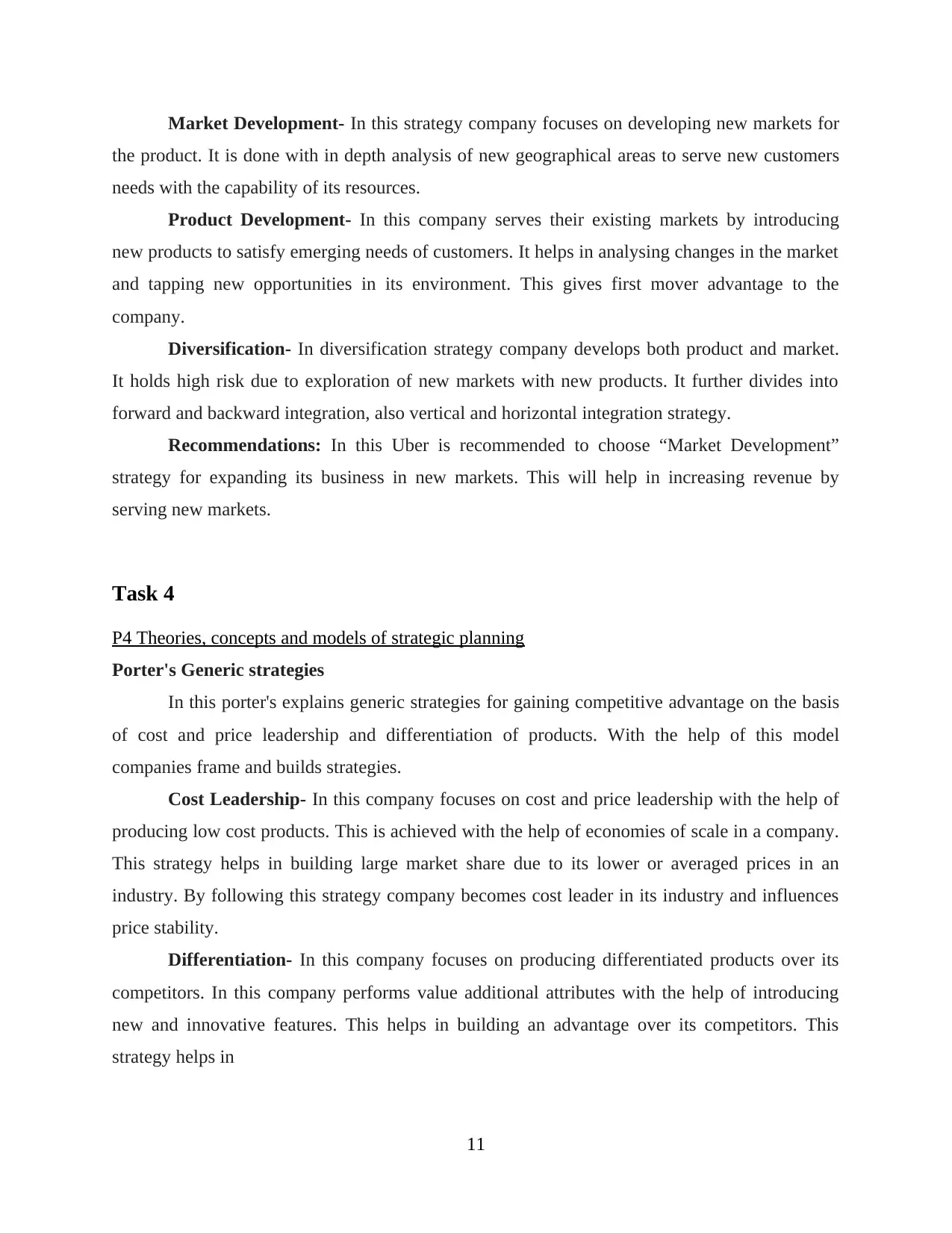
Market Development- In this strategy company focuses on developing new markets for
the product. It is done with in depth analysis of new geographical areas to serve new customers
needs with the capability of its resources.
Product Development- In this company serves their existing markets by introducing
new products to satisfy emerging needs of customers. It helps in analysing changes in the market
and tapping new opportunities in its environment. This gives first mover advantage to the
company.
Diversification- In diversification strategy company develops both product and market.
It holds high risk due to exploration of new markets with new products. It further divides into
forward and backward integration, also vertical and horizontal integration strategy.
Recommendations: In this Uber is recommended to choose “Market Development”
strategy for expanding its business in new markets. This will help in increasing revenue by
serving new markets.
Task 4
P4 Theories, concepts and models of strategic planning
Porter's Generic strategies
In this porter's explains generic strategies for gaining competitive advantage on the basis
of cost and price leadership and differentiation of products. With the help of this model
companies frame and builds strategies.
Cost Leadership- In this company focuses on cost and price leadership with the help of
producing low cost products. This is achieved with the help of economies of scale in a company.
This strategy helps in building large market share due to its lower or averaged prices in an
industry. By following this strategy company becomes cost leader in its industry and influences
price stability.
Differentiation- In this company focuses on producing differentiated products over its
competitors. In this company performs value additional attributes with the help of introducing
new and innovative features. This helps in building an advantage over its competitors. This
strategy helps in
11
the product. It is done with in depth analysis of new geographical areas to serve new customers
needs with the capability of its resources.
Product Development- In this company serves their existing markets by introducing
new products to satisfy emerging needs of customers. It helps in analysing changes in the market
and tapping new opportunities in its environment. This gives first mover advantage to the
company.
Diversification- In diversification strategy company develops both product and market.
It holds high risk due to exploration of new markets with new products. It further divides into
forward and backward integration, also vertical and horizontal integration strategy.
Recommendations: In this Uber is recommended to choose “Market Development”
strategy for expanding its business in new markets. This will help in increasing revenue by
serving new markets.
Task 4
P4 Theories, concepts and models of strategic planning
Porter's Generic strategies
In this porter's explains generic strategies for gaining competitive advantage on the basis
of cost and price leadership and differentiation of products. With the help of this model
companies frame and builds strategies.
Cost Leadership- In this company focuses on cost and price leadership with the help of
producing low cost products. This is achieved with the help of economies of scale in a company.
This strategy helps in building large market share due to its lower or averaged prices in an
industry. By following this strategy company becomes cost leader in its industry and influences
price stability.
Differentiation- In this company focuses on producing differentiated products over its
competitors. In this company performs value additional attributes with the help of introducing
new and innovative features. This helps in building an advantage over its competitors. This
strategy helps in
11
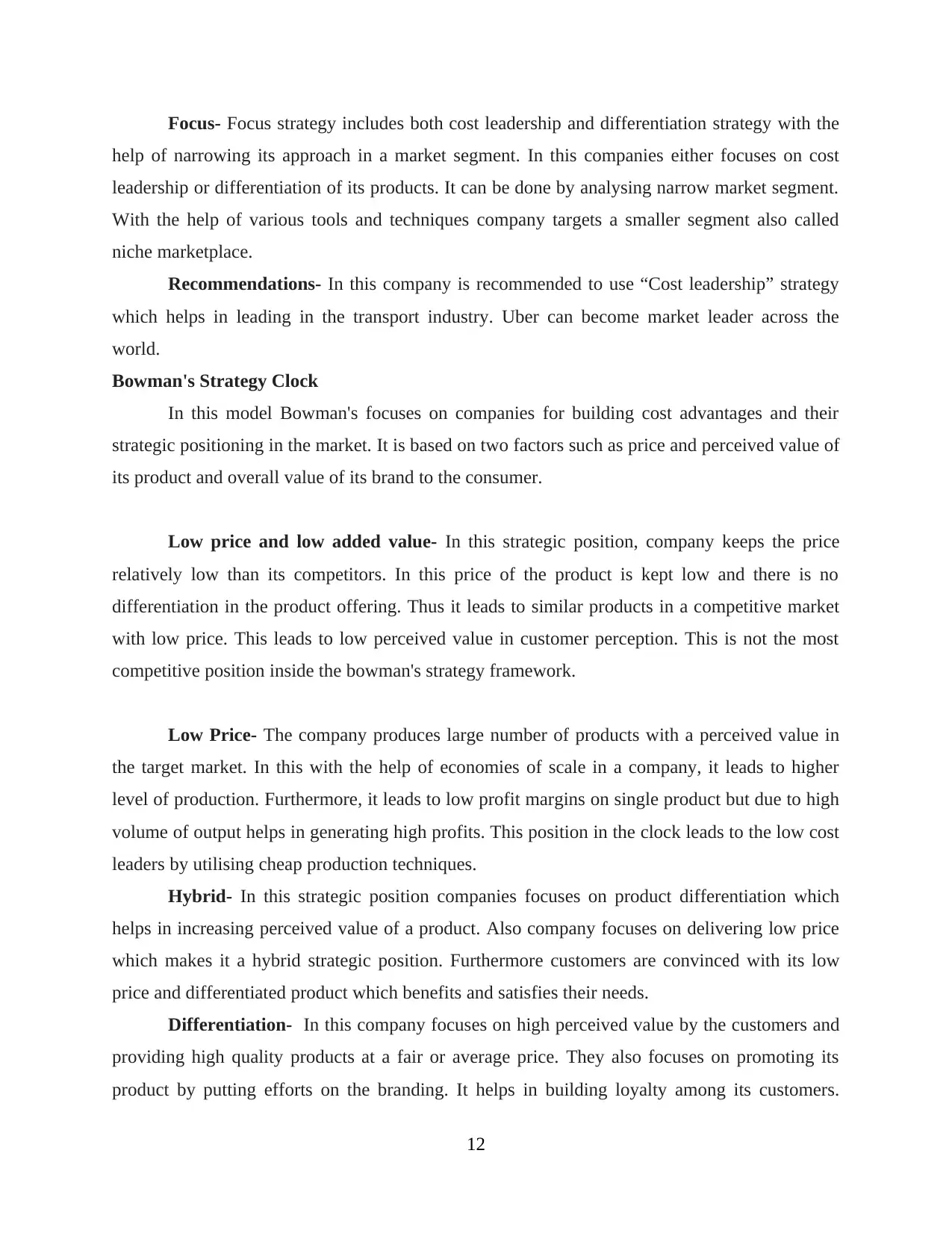
Focus- Focus strategy includes both cost leadership and differentiation strategy with the
help of narrowing its approach in a market segment. In this companies either focuses on cost
leadership or differentiation of its products. It can be done by analysing narrow market segment.
With the help of various tools and techniques company targets a smaller segment also called
niche marketplace.
Recommendations- In this company is recommended to use “Cost leadership” strategy
which helps in leading in the transport industry. Uber can become market leader across the
world.
Bowman's Strategy Clock
In this model Bowman's focuses on companies for building cost advantages and their
strategic positioning in the market. It is based on two factors such as price and perceived value of
its product and overall value of its brand to the consumer.
Low price and low added value- In this strategic position, company keeps the price
relatively low than its competitors. In this price of the product is kept low and there is no
differentiation in the product offering. Thus it leads to similar products in a competitive market
with low price. This leads to low perceived value in customer perception. This is not the most
competitive position inside the bowman's strategy framework.
Low Price- The company produces large number of products with a perceived value in
the target market. In this with the help of economies of scale in a company, it leads to higher
level of production. Furthermore, it leads to low profit margins on single product but due to high
volume of output helps in generating high profits. This position in the clock leads to the low cost
leaders by utilising cheap production techniques.
Hybrid- In this strategic position companies focuses on product differentiation which
helps in increasing perceived value of a product. Also company focuses on delivering low price
which makes it a hybrid strategic position. Furthermore customers are convinced with its low
price and differentiated product which benefits and satisfies their needs.
Differentiation- In this company focuses on high perceived value by the customers and
providing high quality products at a fair or average price. They also focuses on promoting its
product by putting efforts on the branding. It helps in building loyalty among its customers.
12
help of narrowing its approach in a market segment. In this companies either focuses on cost
leadership or differentiation of its products. It can be done by analysing narrow market segment.
With the help of various tools and techniques company targets a smaller segment also called
niche marketplace.
Recommendations- In this company is recommended to use “Cost leadership” strategy
which helps in leading in the transport industry. Uber can become market leader across the
world.
Bowman's Strategy Clock
In this model Bowman's focuses on companies for building cost advantages and their
strategic positioning in the market. It is based on two factors such as price and perceived value of
its product and overall value of its brand to the consumer.
Low price and low added value- In this strategic position, company keeps the price
relatively low than its competitors. In this price of the product is kept low and there is no
differentiation in the product offering. Thus it leads to similar products in a competitive market
with low price. This leads to low perceived value in customer perception. This is not the most
competitive position inside the bowman's strategy framework.
Low Price- The company produces large number of products with a perceived value in
the target market. In this with the help of economies of scale in a company, it leads to higher
level of production. Furthermore, it leads to low profit margins on single product but due to high
volume of output helps in generating high profits. This position in the clock leads to the low cost
leaders by utilising cheap production techniques.
Hybrid- In this strategic position companies focuses on product differentiation which
helps in increasing perceived value of a product. Also company focuses on delivering low price
which makes it a hybrid strategic position. Furthermore customers are convinced with its low
price and differentiated product which benefits and satisfies their needs.
Differentiation- In this company focuses on high perceived value by the customers and
providing high quality products at a fair or average price. They also focuses on promoting its
product by putting efforts on the branding. It helps in building loyalty among its customers.
12
⊘ This is a preview!⊘
Do you want full access?
Subscribe today to unlock all pages.

Trusted by 1+ million students worldwide
1 out of 16
Related Documents
Your All-in-One AI-Powered Toolkit for Academic Success.
+13062052269
info@desklib.com
Available 24*7 on WhatsApp / Email
![[object Object]](/_next/static/media/star-bottom.7253800d.svg)
Unlock your academic potential
Copyright © 2020–2025 A2Z Services. All Rights Reserved. Developed and managed by ZUCOL.





